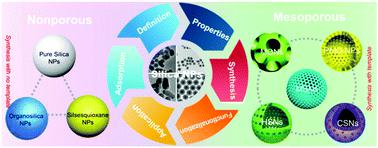Our official English website, www.x-mol.net, welcomes your
feedback! (Note: you will need to create a separate account there.)
Functionalized silica nanoparticles: classification, synthetic approaches and recent advances in adsorption applications
Nanoscale ( IF 5.8 ) Pub Date : 2021-08-26 , DOI: 10.1039/d1nr04048k Hao Li 1, 2 , Xueping Chen 1 , Danqing Shen 1 , Fan Wu 1 , Roser Pleixats 3 , Jianming Pan 1
Nanoscale ( IF 5.8 ) Pub Date : 2021-08-26 , DOI: 10.1039/d1nr04048k Hao Li 1, 2 , Xueping Chen 1 , Danqing Shen 1 , Fan Wu 1 , Roser Pleixats 3 , Jianming Pan 1
Affiliation

|
Nanotechnology is rapidly sweeping through all the vital fields of science and technology such as electronics, aerospace, defense, medicine, and catalysis. It involves the design, synthesis, characterization, and applications of materials and devices on the nanometer scale. At the nanoscale, physical and chemical properties differ from the properties of the individual atoms and molecules of bulk matter. In particular, the design and development of silica nanomaterials have captivated the attention of several researchers worldwide. The applications of hybrid silicas are still limited by the lack of control on the morphology and particle size. The ability to control both the size and morphology of the materials and to obtain nano-sized silica particles has broadened the spectrum of applications of mesoporous organosilicas and/or has improved their performances. On the other hand, adsorption is a widely used technique for the separation and removal of pollutants (metal ions, dyes, organics,...) from wastewater. Silica nanoparticles have specific advantages over other materials for adsorption applications due to their unique structural characteristics: a stable structure, a high specific surface area, an adjustable pore structure, the presence of silanol groups on the surface which allow easy modification, less environmental harm, simple synthesis, low cost, etc. Silica nanoparticles are potential adsorbents for pollutants. We present herein an overview of the different types of silica nanoparticles going from the definitions to properties, synthetic approaches and the mention of potential applications. We focus mainly on the recent advances in the adsorption of different target substances (metal ions, dyes and other organics).
中文翻译:

功能化二氧化硅纳米粒子:分类、合成方法和吸附应用的最新进展
纳米技术正在迅速席卷电子、航空航天、国防、医学和催化等所有重要的科学技术领域。它涉及纳米级材料和器件的设计、合成、表征和应用。在纳米尺度上,物理和化学性质不同于散装物质的单个原子和分子的性质。尤其是二氧化硅纳米材料的设计和开发引起了世界范围内一些研究人员的关注。由于缺乏对形态和粒径的控制,混合二氧化硅的应用仍然受到限制。控制材料的尺寸和形态以及获得纳米二氧化硅颗粒的能力拓宽了介孔有机二氧化硅的应用范围和/或提高了它们的性能。另一方面,吸附是一种广泛用于从废水中分离和去除污染物(金属离子、染料、有机物...)的技术。由于其独特的结构特征,二氧化硅纳米粒子在吸附应用中具有优于其他材料的特殊优势:结构稳定、比表面积高、孔结构可调、表面存在硅烷醇基团,易于改性,对环境的危害较小,合成简单,成本低,有机物,...)来自废水。由于其独特的结构特征,二氧化硅纳米粒子在吸附应用中具有优于其他材料的特殊优势:结构稳定、比表面积高、孔结构可调、表面存在硅烷醇基团,易于改性,对环境的危害较小,合成简单,成本低,有机物,...)来自废水。由于其独特的结构特征,二氧化硅纳米粒子在吸附应用中具有优于其他材料的特殊优势:结构稳定、比表面积高、孔结构可调、表面存在硅烷醇基团,易于改性,对环境的危害较小,合成简单,成本低,等。二氧化硅纳米粒子是污染物的潜在吸附剂。我们在此概述了不同类型的二氧化硅纳米粒子,从定义到特性、合成方法和潜在应用的提及。我们主要关注吸附不同目标物质(金属离子、染料和其他有机物)的最新进展。
更新日期:2021-09-21
中文翻译:

功能化二氧化硅纳米粒子:分类、合成方法和吸附应用的最新进展
纳米技术正在迅速席卷电子、航空航天、国防、医学和催化等所有重要的科学技术领域。它涉及纳米级材料和器件的设计、合成、表征和应用。在纳米尺度上,物理和化学性质不同于散装物质的单个原子和分子的性质。尤其是二氧化硅纳米材料的设计和开发引起了世界范围内一些研究人员的关注。由于缺乏对形态和粒径的控制,混合二氧化硅的应用仍然受到限制。控制材料的尺寸和形态以及获得纳米二氧化硅颗粒的能力拓宽了介孔有机二氧化硅的应用范围和/或提高了它们的性能。另一方面,吸附是一种广泛用于从废水中分离和去除污染物(金属离子、染料、有机物...)的技术。由于其独特的结构特征,二氧化硅纳米粒子在吸附应用中具有优于其他材料的特殊优势:结构稳定、比表面积高、孔结构可调、表面存在硅烷醇基团,易于改性,对环境的危害较小,合成简单,成本低,有机物,...)来自废水。由于其独特的结构特征,二氧化硅纳米粒子在吸附应用中具有优于其他材料的特殊优势:结构稳定、比表面积高、孔结构可调、表面存在硅烷醇基团,易于改性,对环境的危害较小,合成简单,成本低,有机物,...)来自废水。由于其独特的结构特征,二氧化硅纳米粒子在吸附应用中具有优于其他材料的特殊优势:结构稳定、比表面积高、孔结构可调、表面存在硅烷醇基团,易于改性,对环境的危害较小,合成简单,成本低,等。二氧化硅纳米粒子是污染物的潜在吸附剂。我们在此概述了不同类型的二氧化硅纳米粒子,从定义到特性、合成方法和潜在应用的提及。我们主要关注吸附不同目标物质(金属离子、染料和其他有机物)的最新进展。











































 京公网安备 11010802027423号
京公网安备 11010802027423号